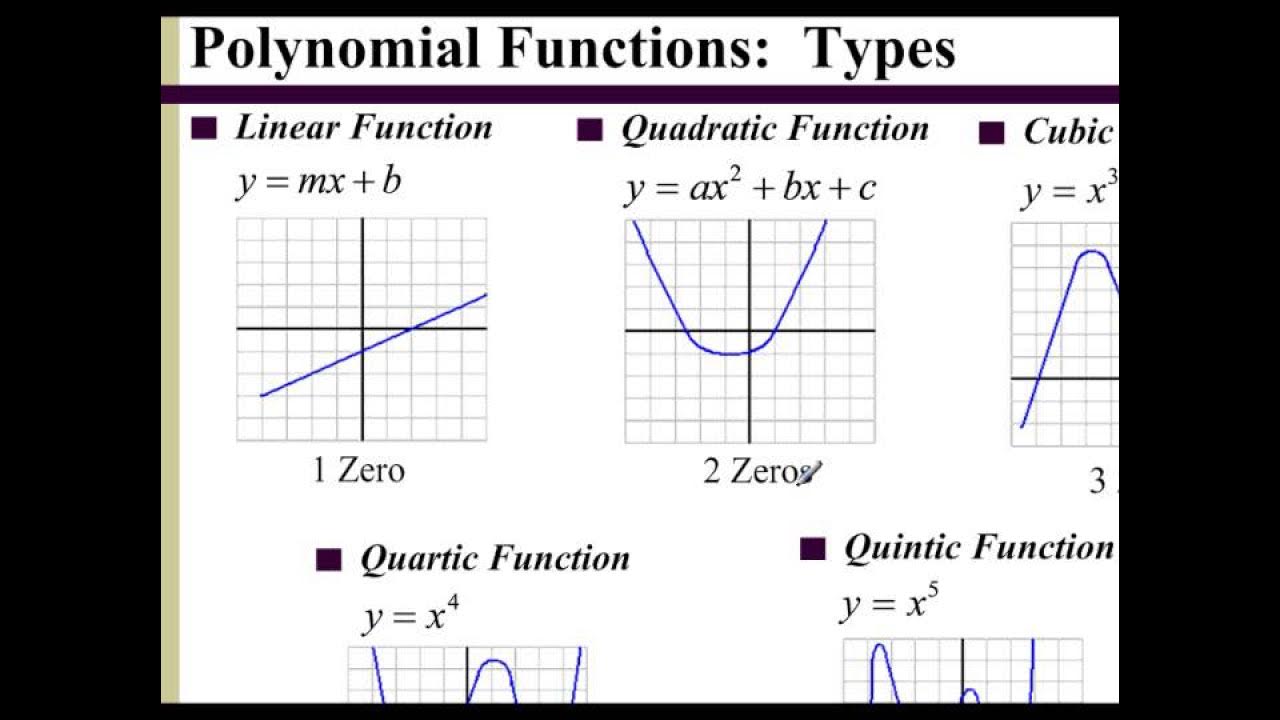Polynomial Functions | Don't Memorise
Summary
TLDRThis video provides a comprehensive introduction to polynomial functions, defining them as expressions with real coefficients and non-negative integer powers of a single variable. It explains key concepts such as the unique powers of terms, the standard form of polynomials, and how to determine their degree. The video also differentiates between polynomial functions and non-polynomial ones through examples, illustrating the importance of coefficients and the structure of various terms. This foundational knowledge sets the stage for understanding more complex mathematical concepts in future lessons.
Takeaways
- 😀 A polynomial function is defined as f(X) = a_n * X^n + a_(n-1) * X^(n-1) + ... + a_0, where each term has a unique power of X.
- 📏 A polynomial function only involves one variable, X, and its terms are raised to non-negative integral powers.
- 🔢 The coefficients of the polynomial (a_0, a_1, ..., a_n) are real numbers associated with each term of X.
- ⬇️ Terms can be arranged in either increasing or decreasing order of the powers of X, but the standard form is in descending order.
- 📈 The degree of a polynomial is determined by the highest power of X, denoted as n, provided that the coefficient of X^n is not zero.
- ❌ If the leading coefficient (a_n) is zero, the degree of the polynomial decreases to n-1.
- 📊 Common terms in polynomials include the constant term (a_0), linear term (a_1 * X), and quadratic term (a_2 * X^2).
- ✔️ A constant function (like f(X) = 5) is considered a polynomial function of degree 0.
- ❌ Functions like f(X) = 2 * X^(4/5) or f(X) = 6/X^2 are not polynomial functions because they involve fractional or negative powers of X.
- ✨ A polynomial can still be valid even if some X terms are missing, as seen in f(X) = X^4 + X, which is a polynomial function of degree 4.
Q & A
What is a polynomial function?
-A polynomial function is a function of the form f(X) = a_n * X^n + a_(n-1) * X^(n-1) + ... + a_0, where the terms are composed of coefficients and variables raised to non-negative integral powers.
How many variables are present in a polynomial function?
-A polynomial function typically has only one variable, denoted as X.
What does it mean for the powers of X to be unique in a polynomial function?
-It means that no two terms in the polynomial have the same exponent for X; each term has a different power.
What is the significance of the constant term a_0 in a polynomial function?
-The constant term a_0 represents the value of the function when X is 0 and corresponds to the term a_0 * X^0, where X^0 equals 1.
What is the standard form of a polynomial function?
-The standard form of a polynomial function is when the terms are written in descending order of their powers, from the highest to the lowest.
How is the degree of a polynomial function determined?
-The degree of a polynomial function is determined by the highest power of X in the function. If the coefficient of that term is not zero, the degree is n.
What happens if the leading coefficient a_n equals zero?
-If a_n equals zero, the term a_n * X^n becomes zero, and the degree of the polynomial decreases to n - 1.
Can a polynomial function have missing terms?
-Yes, a polynomial function can have missing terms, as long as the remaining terms still follow the rules of polynomial functions.
Are functions like f(X) = 6/X^2 polynomial functions?
-No, functions like f(X) = 6/X^2 are not polynomial functions because they include terms with negative powers.
What distinguishes polynomial functions from other types of functions?
-Polynomial functions are distinguished by having non-negative integral powers of the variable X and real coefficients, whereas other functions can include fractional or negative powers.
Outlines

Dieser Bereich ist nur für Premium-Benutzer verfügbar. Bitte führen Sie ein Upgrade durch, um auf diesen Abschnitt zuzugreifen.
Upgrade durchführenMindmap

Dieser Bereich ist nur für Premium-Benutzer verfügbar. Bitte führen Sie ein Upgrade durch, um auf diesen Abschnitt zuzugreifen.
Upgrade durchführenKeywords

Dieser Bereich ist nur für Premium-Benutzer verfügbar. Bitte führen Sie ein Upgrade durch, um auf diesen Abschnitt zuzugreifen.
Upgrade durchführenHighlights

Dieser Bereich ist nur für Premium-Benutzer verfügbar. Bitte führen Sie ein Upgrade durch, um auf diesen Abschnitt zuzugreifen.
Upgrade durchführenTranscripts

Dieser Bereich ist nur für Premium-Benutzer verfügbar. Bitte führen Sie ein Upgrade durch, um auf diesen Abschnitt zuzugreifen.
Upgrade durchführenWeitere ähnliche Videos ansehen

Lesson 6.3 - Identifying a Polynomial Function from the Graph

Illustrate Polynomial Functions | Second Quarter | Grade 10 MELC

Ganzrationale Funktionen (Polynomfunktionen) - Einführung / Grundlagen

Materi Polinomial kelas XI MIPA Matematika Peminatan Pertemuan 1- PPL 2 PPG Prajabatan Gel 1

Polinomial (Bagian 1) - Pengertian dan Operasi Aljabar Polinomial Matematika Peminatan Kelas XI

KESAMAAN POLINOMIAL (1)
5.0 / 5 (0 votes)
